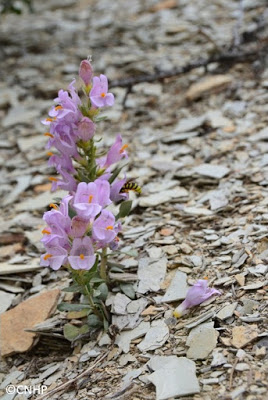During a recent rare plant survey funded by the U.S. Fish and Wildlife Service, CNHP botanist/ecologist Delia Malone discovered a new population of Graham’s beardtongue (Penstemon grahamii) south of Rangely, Colorado. This rare plant is known from only six other occurrences in the state of Colorado. Graham’s beardtongue is found on raw shale slopes and knolls of the Green River Formation in Rio Blanco County, Colorado, as well as three counties in eastern Utah: Carbon, Duchesne, and Uintah.
The bright white and caramel-colored shales of the Green River Formation, which often look like pieces of broken plates, give rise to highly basic soils. These soils support a very unique plant community dominated by dwarf shrubs like spiny greasebush (Glossopetalon spinescens) and shadcale saltbush (Atriplex confertifolia). Forbs species such as dragon milkvetch (Astragalus lutosus) and ephedra buckwheat (Eriogonum ephedroides) are also commonly found growing on Green River shales in occupied Graham’s beardtongue habitat. This species is considered Sensitive by the BLM.
 |
| Lured in by the bright yellow, protruding staminode called a beardtongue, a Pseudomasaris wasp lands inside the corolla of a rare Graham’s beardtongue outside of Rangely, Colorado. |




